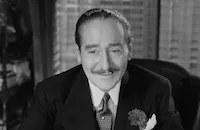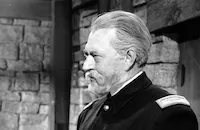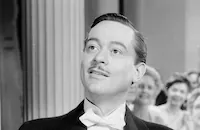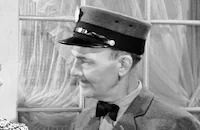The Sniper

Brief Synopsis
Cast & Crew
Edward Dmytryk
Adolphe Menjou
Arthur Franz
Gerald Mohr
Marie Windsor
Frank Faylen
Film Details
Technical Specs

Synopsis
Edward Miller, a driver for a dry cleaning company, suffers through the psychological torments of despising women. Surrounded by a carping landlady and shrewish female co-workers, he fantasizes about murdering women, while brandishing an empty rifle. Eddie seeks help from his former physician at the local state prison and becomes distraught when he discovers the doctor is on vacation. In a frantic effort to get help, Eddie purposely burns his hand by placing it on a hotplate. At the hospital the intern, suspicious that the wound was self-inflicted, asks Eddie if he was ever in a mental hospital, and Eddie admits that he was while in prison serving time for assaulting a woman. When the intern consults with a doctor about sending Eddie to the psychiatric ward, the doctor points out that Eddie would be held for only three days and then released. Late for work, Eddie hurries to make a delivery to nightclub singer Jean Darr, who is trying on a low-cut evening gown when he arrives. Jean notices a stain on her gown and asks Eddie if he might do a rush order on it. Eddie agrees and Jean chats pleasantly with him, until a male friend interrupts them. Jean curtly pushes Eddie out the back entrance with the gown. That night, Eddie waits outside of Jean's apartment, carrying his rifle in a small case, and follows her as she walks several blocks to the club at which she performs. Eddie sneaks onto the apartment building rooftop across the street and waits until Jean comes out, then shoots her. Police detectives Lt. Frank Kafka and Sgt. Joe Ferris arrive on the scene and take charge of the investigation. The next day, Eddie flirts with a woman in a bar but although she gives him her address and phone number, Eddie grows angry when she traps him in the lies he has told about his job. Later that day, Eddie takes Jean's gown to his room and hides it, but when he suffers a series of humiliating encounters in the park, he returns to his room, tears the dress and burns it in the incinerator. After staring at the address of the woman from the bar, Eddie rips the top off a box of ammunition and writes a note to the police pleading to be stopped as "he's going to kill again." That afternoon, Eddie follows the woman from the bar and shoots her through the window of her apartment. Kafka meets with Inspector Anderson who, in receipt of the box top, orders a roundup of local sex offenders for a lineup from some witnesses. Psychiatrist Dr. James G. Kent tells Kafka that none of the offenders are guilty and later at a restaurant gives Kafka a profile of the murderer as fulfilling a childhood fantasy of killing a particular woman, such as his mother, over and over. Meanwhile, in town, Eddie notices a television program through the window of a store and becomes fixated on society matron Mrs. Fitzpatrick, who is discussing a charity ball. He makes a mental note of her address as she gives it out for tickets. While going through an extensive list of criminal profiles, Kafka and Ferris come across Eddie's record, which lists his assault on a woman with a baseball bat. Just then a report comes in that Mrs. Fitzpatrick has been shot to death. The police are then summoned to a meeting with the mayor and several of the city's political bosses, who demand the killer be found. Dr. Kent grows frustrated when each of the politicos discuss severe punishment for the killer rather than treatment. At the cleaners, Eddie is nagged again by the receptionist, who wonders why Eddie has not changed the dirty bandage on his hand. Later, a woman's body is found shot to death in a local park, and bullet casings and a dirty bandage are discovered nearby. While Eddie burns off his frustration at a local amusement park, Kafka and Ferris have the bandage analyzed and track it to a hospital. There, despite the fact that Eddie registered under another name, the intern indentifies him from the photo in his criminal file. When the cleaner's receptionist reads the newspaper story about the latest murder, she immediately reports Eddie's hand injury and erratic behavior. Kafka and Ferris wait for Eddie at the cleaners, but he is on a local rooftop desperately tracking lone women. When a painter working high on an opposite building sees Eddie and calls a warning to those below, Eddie kills him and frantically flees for home. The police and curious bystanders surround Eddie's building and Inspector Anderson calls to him on a bullhorn to no avail. Kafka and Ferris shoot their way into Eddie's room, where they find him, petrified, clinging to his rifle.

Director

Edward Dmytryk
Cast

Adolphe Menjou

Arthur Franz
Gerald Mohr

Marie Windsor
Frank Faylen

Richard Kiley
Mabel Paige
Marlo Dwyer
Geraldine Carr
Jay Novello
Ralph Peters
Max Palmer
Sidney Miller
Hurb Latimer
Dani Sue Nolan
Harry Cheshire
Cliff Clark
Robert Foulk
Fred Hartman
Don Michaelian
Renaldo Viri
Kernan Cripps
Rory Mallinson
J. Anthony Hughes
Danny Mummert
George Dockstader
Les Sketchley

Carl Benton Reid

Byron Foulger
Roy Maypole
Paul Marion
Al Hill
Grandon Rhodes
Kay Sharpe

Harlan Warde
John Brown

John Eldredge
Patricia Toun
Elizabeth Whitney
Isabel Withers
Helen Lindstrom
Wanda Wirth
Luanna Scott
Marlene Lyden
Robin Raymond
Fran Shaw
Joe Miksak
Richard Glyer
Howard Negley
David Mcmahon
Robert Malcom
Charles Watts
Steve Darrell
Willis West
Norman Nazarr
John Bradley
Nolan Leary
Billy Wayne
Ralph Smiley
John Pickard
Joe Mell
H. George Stern
Frank Kreig
Ralph Volkie
Victor Sen Yung
Charles Wagenheim
Gail Bonney
Harry Harvey
Gaylord Pendleton
Clark Howat
Robert B. Williams
Dudley Dickerson

John A. Butler
Edgar Novack
Mike Lally
Barry Brooks
Bruce Cameron
Tommy Hawkins
Lucas Farara
Charles Marsh

Jean Willes
Kathleen O'malley
Lillian Bond
George Chesbro

Charles Lane
Frank Sully
James Sheldon
John H. Algate
Vern Martell
Thomas Heidt
Kathleen O'reilly
Elsa Weber
Helen Eliot
Aline Watson
Richard Freye
Harry Bechtel
Mary Holly
Robert Day
Alice Bartlett
Betty Shute
Paul Du Bov
Warren Mace
Sarah Selby
Adrienne Marden
Jessie Arnold
Joe Palma
Donald Kerr
Crew
Edna Anhalt
Edna Anhalt
Edward Anhalt
Edward Anhalt
George Antheil
Clem Beauchamp
Harry Brown
James Crowe
Milton Feldman
Harry Gerstad
Frank Goodwin
Burnett Guffey
Walter Holscher
Stanley Kramer
Aaron Stell
Rudolph Sternad
Morris Stoloff

Videos
Movie Clip







Hosted Intro
Film Details
Technical Specs

Award Nominations
Best Writing, Screenplay
Articles
The Sniper
Shot on an amazingly short schedule of eighteen days with location work in both San Francisco and Long Beach, The Sniper was produced by Stanley Kramer who was well known for his interest in controversial and provocative subject matter (racism in Home of the Brave [1949], the rehabilitation of war veterans in The Men [1950], hypocrisy and cowardice in High Noon [1952]). He decided to offer this particular project to Edward Dmytryk, who had just finished serving a jail sentence for refusing to cooperate with the House Committee on Un-American Activities. Considering the political climate of the country at that time - one in which a communist witch-hunt had resulted in a Hollywood blacklist - Kramer's decision was a daring one but he knew Dmytryk was a talented director. And The Sniper marked the beginning of a four picture deal between Kramer and Dmytryk.
The Daily Worker, the New York City based Communist newspaper, was one of the first to publicly attack the film in print: "Movie director Edward Dmytryk, ex-member of the Hollywood Ten who turned informer for the FBI, is now palsy-walsy with his erstwhile foe - the rabid witch-hunter and haberdasher's gentleman - Adolphe Menjou. Now Dmytryk and Menjou are together again - this time as friends. Menjou has a leading role in The Sniper, which Dmytryk, gone over to warmongering and restored to favor of the Big Money, is now directing for Stanley Kramer productions."
In his autobiography, It's a Hell of a Life But Not a Bad Living, Dmytryk stated that he, Kramer and the screenwriters Edward and Edna Anhalt had decided on Menjou as an inspired bit of offbeat casting. "As a run-of-the-mill police detective, Menjou shaved off his moustache, wore cheap suits and shoes, and was as far removed from the haberdasher's gentleman as we could reasonably get," Dmytryk stated. "Regardless of his extremist views, he had always been a fine actor, and he did an excellent job in our film. We were still at opposite poles politically, though neither of us, as far as I knew, was doing any warmongering. Menjou also received some criticism from his fellow-reactionaries - one of whom asked why he had agreed to work with me. "Because I'm a whore!" he snapped. There always has to be a place in my heart for honesty."
In addition to the controversy over Kramer's decision to hire Dmytryk as the director, The Sniper also ran into trouble with the Production Code office, Hollywood's censorship bureau which was headed by Joseph Breen. According to an interview with screenwriter Edward Anhalt, "We got a letter saying this film cannot be made. It violated section 27 paragraph 4 of the Code, which actually said perversion cannot be the subject of a motion picture. So I was appointed to go to the board and fight for it. I said 'This doesn't violate the rule at all, because it's not about perversion.' So he [Breen], furious at me, said, 'What are you talkin' about it's not about perversion? It's about a man who gets an orgasm from shooting women! That's not perversion?' I said, 'No, perversion would be if he got an orgasm from shooting men.' [laughs] And for some incredible reason they bought it, and that's how we got the picture made."
Despite the film's focus on the psychological aspects of the story, The Sniper still has the no-nonsense approach and fast-paced style of a superior B-movie suspense thriller. Arthur Franz, an excellent character actor who rarely got the opportunity to prove himself in leading roles, is both creepy and sympathetic as the mentally disturbed Eddie. [SPOILER ALERT] Marie Windsor, a memorable presence in such classic noirs as The Narrow Margin [1952] and The Killing [1956], also registers strongly in a supporting role as one of the unfortunate victims. The scene where she is shot outside a bar and the impact of the bullet sends her body crashing through a plate glass window still wields a blunt power today and must have been truly shocking for fifties audiences.
Dmytryk's first film for Kramer proved he hadn't lost any of the visual imagination or directorial skills he displayed so prominently in Murder, My Sweet (1944) and Crossfire (1947). And he managed to add something fresh and new to scenes of the police manhunt in The Sniper. "Our film included a rooftop chase of a "copycat" sniper," he recalled. "Everyone has seen dozens of rooftop chases, and I wanted something different. After a brief mental bout, I came up with the idea of rooftop clotheslines hung with laundry, which I had never seen used in chase scenes. Having too many other problems facing me at the moment, I tossed the laundry idea to the sketch artist. In a couple of days, he brought me a very unusual and photogenic conception of a chase through a sea of flapping sheets. It made an interesting and unusual sequence out of what might otherwise have been something quite routine." The final sequence as well, in which Eddie is caught in the act of sniping by a man climbing a smokestack behind him, is another offbeat but memorable moment that Edward Anhalt based on an incident he actually witnessed.
According to Stanley Kramer, "When Harry Cohn [Head of Columbia Pictures] saw The Sniper in a studio screening room, he said, "This thing stinks. I hate it, and it'll never make a nickel." The few mainstream critics who reviewed it were also mixed in their reactions with The New York Times' Bosley Crowther voicing a common criticism: "...the preachment is primly academic and it seems but a dignified excuse for working a slightly different angle into a simple man-hunt on the screen...the menace and understanding of the sex fiend hopefully implied in the foreward to the picture are never clearly revealed." The film's publicists didn't help matters either by sending out bullets to critics and industry professionals as part of their pre-release teaser campaign (Kramer's production company quickly apologized with a full-page ad in the Hollywood Reporter). Even a series of real-life sniper attacks by Evan Charles Thomas in the Los Angeles area just prior to the film's opening didn't generate any widespread curiosity about Dmytryk's film.
As Cohn predicted, The Sniper performed poorly at the box office but its reputation is considerably better today where it is recognized as not just a tautly-directed film noir but a critique of contemporary society and urban alienation inviting comparisons to Martin Scorsese's later Taxi Driver (1976). It also didn't go unnoticed during the Academy Award nominations of its release year, garnering an Oscar nomination for Best Writing, Motion Picture Story.
Producer: Edna Anhalt, Edward Anhalt, Stanley Kramer
Director: Edward Dmytryk
Screenplay: Edna Anhalt, Edward Anhalt, Harry Brown
Cinematography: Burnett Guffey
Film Editing: Aaron Stell
Art Direction: Walter Holscher
Music: George Antheil
Cast: Adolphe Menjou (Police Lt. Frank Kafka), Arthur Franz (Eddie Miller), Gerald Mohr (Police Sgt. Joe Ferris), Marie Windsor (Jean Darr), Frank Faylen (Police Inspector Anderson), Richard Kiley (Dr. James Kent).
BW-87m.
by Jeff Stafford
SOURCES:
It's a Hell of a Life But Not a Bad Living: A Hollywood Memoir by Edward Dmytryk (Times Books)
A Mad, Mad, Mad, Mad World: A Life in Hollywood by Stanley Kramer with Thomas M. Coffey (Harcourt Brace & Co.)
TCM Archives Interview with Edward Anhalt
AFI
IMDB

The Sniper
Quotes
Trivia
Notes
The following written prologue precedes the opening credits: "A word about the picture which follows: High among police problems is that of the sex criminal, responsible last year alone for offenses which victimized 31,175 women. Adequate and understanding laws do not exist. Law enforcement is helpless. Here, in terms of one case, is the story of a man whose enemy was womankind." Reviews described the character of "Eddie" as a "sex criminal," and the film depicts the police grilling known sex offenders; while there was no indication Eddie molested his victims, in the film, his clear hatred of women identified him as a sex criminal.
The Hollywood Reporter review indicated that the film mirrored a series of recent sniper shootings in the Los Angeles area. Roy Maypole, a Los Angeles television news broadcaster, played a broadcaster in the film. Although a Hollywood Reporter news item indicated that broadcaster Howard K. Smith was cast in the picture, he was not in the released film. The film was shot on location in San Francisco and Long Beach, CA. In a full-page ad for The Sniper in Hollywood Reporter, the Stanley Kramer Co. apologized for sending out bullets to critics and industry personnel as part of a pre-invitational screening "teaser." Edward and Edna Anhalt's screen story received an Academy Award nomination in the Writing (Motion Picture Story) category.
















